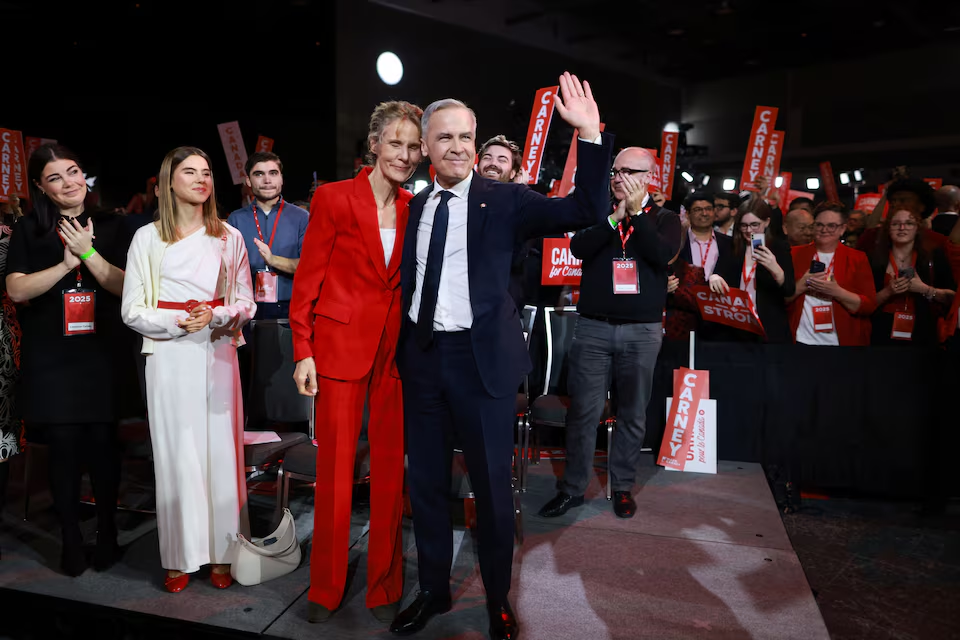In a historic turn of events, former central banker Mark Carney has won the Liberal Party leadership race and is set to replace Justin Trudeau as Canada’s prime minister. Carney, a political newcomer, secured an overwhelming 86% of the votes, defeating former Finance Minister Chrystia Freeland in a contest that saw nearly 152,000 party members cast their ballots.
Carney’s victory comes at a critical time for Canada, as the country faces a tense trade war with the United States under President Donald Trump and prepares for an upcoming federal election. With Trudeau stepping down after more than nine years in power, Carney’s leadership marks a new chapter for the Liberal Party and Canadian politics.
In this article, we’ll explore:
- How Mark Carney won the Liberal leadership race;
- His plans to address Canada’s challenges, including the trade war with the U.S.;
- What his leadership means for the future of Canadian politics; and
- The upcoming federal election and its potential impact.
Let’s dive in!
Who Is Mark Carney?
Mark Carney is a renowned economist and former central banker who served as the governor of the Bank of Canada and the Bank of England. With no prior political experience, Carney’s entry into the Liberal leadership race was seen as a bold move. However, his extensive background in economics and international finance positioned him as a strong candidate to lead Canada through its current challenges.
Carney’s campaign focused on revitalizing the Liberal Party, addressing economic issues, and standing up to President Trump’s aggressive trade policies. His victory signals a shift in Canadian politics, as voters look for fresh leadership to navigate uncertain times.
Why Did Justin Trudeau Step Down?
Justin Trudeau announced his resignation in January 2025, citing declining approval ratings and a desire to pass the torch to new leadership. During his nine years in office, Trudeau implemented significant policies on climate change, immigration, and social justice. However, his government faced criticism over its handling of the economy and trade relations with the U.S.
Trudeau’s departure forced the Liberal Party to hold a swift leadership race, with Carney emerging as the clear favorite. In his farewell speech, Trudeau emphasized the importance of democracy and freedom, urging Canadians to protect these values in the face of global challenges.
Carney’s Plans as Prime Minister
Mark Carney has outlined several key priorities for his leadership, including:
- Standing Up to Trump’s Tariffs: Carney has vowed to defend Canadian workers and businesses against President Trump’s tariffs, which threaten Canada’s export-dependent economy. He has pledged to maintain retaliatory tariffs until the U.S. shows respect for Canada’s interests.
- Revitalizing the Economy: Drawing on his experience as a central banker, Carney plans to implement innovative economic policies to boost growth and create jobs.
- Preparing for the Federal Election: Carney is expected to call an election soon, as the Liberal Party seeks to secure a majority government.
Challenges Ahead for Carney
Carney’s leadership comes with significant challenges, including:
- Trade War with the U.S.: The ongoing trade dispute with the U.S. has strained relations between the two countries. Carney will need to navigate these tensions while protecting Canada’s economic interests.
- Political Opposition: Conservative leader Pierre Poilievre has already ramped up attacks on Carney, comparing him to an outsider with no political experience.
- Public Expectations: Canadians are looking for bold leadership to address pressing issues like the economy, climate change, and healthcare.
What Does This Mean for Canadian Politics?
Carney’s victory has sparked a rallying-around-the-flag moment for the Liberal Party, which was trailing in the polls at the start of 2025. His leadership has revitalized the party’s fortunes, putting it in a competitive position against the Conservatives.
However, polls suggest that neither party is likely to secure a majority government in the upcoming election. This could lead to a minority government, requiring collaboration with other parties to pass legislation.
The Road to the Federal Election
An election must be held by October 20, 2025, but Carney is expected to call one much sooner. As a political newcomer, Carney will need to win a seat in the House of Commons to solidify his position as prime minister.
The election will be a critical test for Carney and the Liberal Party, as they seek to convince Canadians that they are the best choice to lead the country forward.
What’s Next for Canada?
Mark Carney’s leadership marks a new era for Canada, as the country faces both domestic and international challenges. His ability to navigate these challenges will determine the future of Canadian politics and the economy.
If you’re interested in learning more about how these changes could impact immigration and work permits in Canada, consider scheduling a work permit consultation with an immigration professional.
By staying informed and engaged, Canadians can play a role in shaping the future of their country under Carney’s leadership. The road ahead may be uncertain, but with strong leadership and a united vision, Canada can overcome its challenges and thrive.




